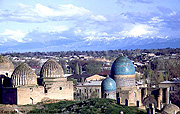
14th-15th century CE
Samarkand, Uzbekistan
Photos copyright © Daniel C. Waugh, 1969-1995
One of the most interesting and important historical sites in Samarkand is the Shah-i Zinde, a mausoleum complex located just northeast of the city. The complex is comprised of some two dozen mausoleums, a number of connected small mosques, and a now sizeable cemetery that has developed around the main buildings. The Shah-i Zinde contains fragments of some of the earliest known Islamic structures in Samarkand, but most of the surviving buildings date from just before Timur's establishment of Samarkand as his capital (i.e., ca. 1360) to about the middle of the following century. There have been continual renovations, some of them very recent, which make it difficult to know original details especially for the upper parts of many of the buildings. Nonetheless, numerous inscriptions, some dated, and the extensive preservation of the ceramic tiles on the buildings provide a unique overview of the architectural decoration for a very significant century in the history of Islamic art in Central Asia.
The famous fourteenth century Arab traveler Abu Abdalla Ibn Battuta was especially interested in recording important holy sites and his interactions with Muslim religious leaders. It seems significant therefore that the only Muslim shrine in Samarkand he chose to describe was that of Qutham (Kusam) Ibn Abbas, in the Shah-i Zinde complex. History has Ibn Abbas dying a martyr's death at the time of the first Arab siege of Samarkand (676/77 CE), yet according to local Samarkand legends (repeated by Ibn Battuta), Ibn Abbas escaped death and living on underground (hence the origins of the name Shah-i Zinde, the "Living King," which specifically referred to him). Veneration of Ibn Abbas initially seems to have begun under the Abbasid caliphs (after 750 CE), whose roots were in Khurasan, though there is no evidence that the shrine existed prior to the 11th century.
The surviving structures that comprise the Ibn Abbas shrine today largely date from the 14th and 15th centuries. Its entrance is in a 14th-century archway that spans the main corridor of the Shah-i Zinde. Entering the shrine, the only tile decorations that have been preserved inside the structure are located in the mihrab, a niche indicating the direction of Mecca. Beyond is an antechamber (the ziyaretkhana) for pilgrims who would pray at the shrine, rebuilt in 1334/35, a date inscribed on the tile work of its ceiling. The squinches (at the corners under the dome) contain excellent examples of tiled muqarnas (stalactite) decoration. The "tomb" itself can be seen through an elegantly carved fourteenth-century wooden screen. There is some disagreement as to the date of the current cenotaph over the burial. Whether it dates from the 1330s might be questioned, since the appearance is very different from the description in Ibn Battuta's text; alternatively, it is dated to the 1380s.
-- Daniel C. Waugh
Follow this link to Waugh's Central Asia for more images and information on the Shah-i Zinde complex, including Ibn Battuta's account of his visit to the site in the early 1330s, and examples of Timurid-era architecture added in the fifteenth century.





